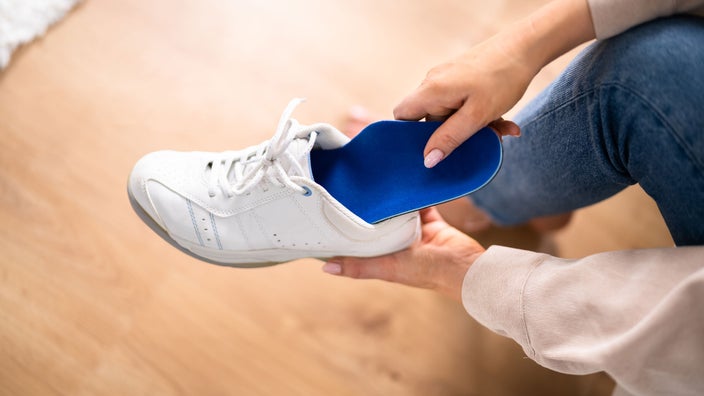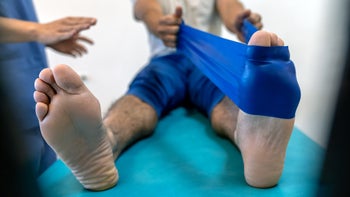
How Much Do Custom Orthotics Cost?
Key takeaways:
Custom orthotics are special shoe inserts that can help with foot pain and other problems. They give your feet extra support tailored to your unique needs.
There are many types of custom orthotics, and they can cost anywhere from $300 to $800. Semi-custom orthotics cost between $60 and $300, and basic off-the-shelf inserts are available for as little as $10 to $20.
Some health insurance plans won’t pay for custom-made orthotics. Other plans may cover custom orthotics only if they’re needed for certain medical conditions.
Table of contents

Foot pain can make it uncomfortable to stand or walk for long periods of time. If over-the-counter shoe inserts aren’t helping you, custom orthotics may be a solution. However, before you invest in a pair, it helps to understand how custom orthotics work and what factors can affect their cost.
How do custom orthotics work?
Custom orthotics offer personalized support and cushioning for your feet and can improve how your feet and ankles move. They can lessen symptoms caused by certain foot conditions, such as high arches and overpronation or supination, which is when your feet roll to one side when you walk or stand. You can find a variety of custom orthotics. Some are available as full-shoe inserts, and others support only your heels.
These devices are specially made to fit your feet. They’re typically prescribed by a podiatrist (an expert in foot and ankle health) or other healthcare professional. To create your orthotics, the healthcare professional will make a mold of your feet or use a computer to create a 3D image of them.
Search and compare options
There are two main types of custom orthotics that healthcare professionals prescribe:
Functional: These orthotics are often made of a semi-rigid material, such as plastic or graphite. They reduce discomfort by controlling foot movement. A healthcare professional may also use functional orthotics to treat injuries such as shin splints.
Accommodative: Unlike functional devices, accommodative orthotics are made of soft and flexible materials. This allows them to mold to the shape of your feet and provide cushion and support. Accommodative orthotics are helpful for conditions such as diabetic foot ulcers.
How much do custom orthotics cost?
The cost of custom orthotics can vary significantly, typically ranging from $300 to $800. Some orthotic stores may charge even more. For example, The Good Feet Store offers personalized arch support systems that can cost $1,000 or more. The price you pay for custom orthotics depends on several factors, including the type of orthotics you choose.
If you’re looking for a more cost-effective option, semi-custom orthotics can be a good choice. These off-the-shelf inserts can be modified to fit your foot and typically cost between $60 and $300. Heat moldable inserts, such as those offered by PowerStep, are a type of semi-custom orthotic. These inserts can be customized by warming them in an oven or by wearing them in your shoes as you walk, allowing them to conform to your foot shape over time.
The least expensive option is a pair of basic over-the-counter inserts, which you can purchase at local stores or online for as little as $10 to $20, though they usually can’t be customized.
What factors affect the cost of custom orthotics?
Several factors can affect how much custom foot orthotics cost. These include:
Type of orthotics: Functional orthotics may be more expensive than accommodative orthotics.
Type of material: Higher-quality materials can increase the cost of the orthotic.
Foot condition: More severe conditions may require more advanced custom orthotics, which can increase the cost.
Manufacturer: Different manufacturers may have different prices for the same type of orthotic.
Office visit fees: You may have to pay out-of-pocket fees to see a podiatrist or another healthcare professional to get a prescription for custom orthotics.
Have flat feet? These exercises can help strengthen your foot arches.
Standing all day can cause foot pain. Wearing compression socks and following these other treatments can help.
Dealing with plantar fasciitis? Here are the best stretches to help you improve your symptoms.
Ultimately, the cost of custom orthotics will depend on your individual needs and circumstances. It’s important to talk to a qualified medical professional before buying orthotics. They can recommend the correct orthotics for your foot condition.
Does insurance cover the cost of custom orthotics?
Some insurance companies do not pay for custom orthotics. Others will only cover them if you have specific medical conditions. Take time to do your research and review your insurance plan’s restrictions.
For example, Cigna covers custom-made foot orthotics for certain conditions, such as diabetic neuropathy or cerebral palsy. You may also be eligible for coverage if you have flat feet and meet certain other criteria. Many insurers also limit how often new orthotics are covered — for example, allowing replacements only once every few years.
Without insurance, you’ll be responsible for paying the full price of your custom orthotics. You may find cheaper options by checking with different manufacturers. Some may offer discounts, special prices, or payment plans. It’s worth exploring your options to find the most affordable solution.
How to get orthotics covered by insurance
To get custom orthotics covered by insurance, follow these steps:
Check your policy: Review your insurance policy or call the health insurer to ask if orthotics are covered and under what conditions.
Get a prescription: Obtain a prescription from a qualified medical professional, typically a podiatrist or primary care professional. In some cases, a letter of medical necessity, explaining why custom orthotics are necessary, may be needed in addition to the prescription.
Choose an in-network provider: Check with your health insurer for the names of in-network podiatrists and orthotic suppliers. When you use in-network providers, you often receive better coverage and pay less out of pocket.
Obtain preauthorization: Some insurers require the prescriber to obtain preauthorization before covering custom orthotics.
Keep documentation: Save all relevant medical records, prescriptions, and receipts.
Appeal if denied: If your claim is denied, you have the right to appeal the decision.
Does Medicare cover orthotics?
If you have foot problems caused by diabetes and are enrolled in Medicare Part B, you may be able to get help paying for custom-molded shoes and inserts, but only if they’re prescribed by a healthcare professional. Medicare Part B will cover 80% of the cost of the orthotics, and you will likely have to pay the Part B deductible as well as the remaining 20% coinsurance.
Benefits of custom orthotics
Healthcare professionals prescribe custom orthotics to help lessen symptoms caused by a variety of conditions, including:
Pes planus (flat feet)
Lower back pain caused by excessive foot pronation
Heel bursitis
Because there are many types of orthotic devices, it’s important to understand which one will be most effective for your condition. For example, soft orthotic cushions may be recommended if you have high arches. But a semi-rigid foot insert might be best if you have painful flat feet. A podiatrist or orthopedic professional can help you determine which type of orthotic is right for you.
Ways to save money when buying custom orthotics
You can save money when you buy custom orthotics by following these five tips:
Check with your insurance provider. If your health plan covers custom orthotics, you may have to pay only a portion of the cost out of pocket.
Use your FSA or HSA. If you have a health savings account (HSA) or flexible spending account (FSA), you can use pretax dollars from those accounts to pay for custom orthotics.
Shop around. Ask about discounts and promotions.
Check the manufacturer’s warranty and guarantee. Some manufacturers offer free adjustments of your orthotics, a warranty, or a money-back guarantee.
Consider getting your orthotics refurbished. You may be able to get your old orthotics refurbished, which can be cheaper than buying a new pair.
Additionally, consider trying a few high-quality over-the-counter orthotics before investing in a pair of custom ones. It’s a cost-effective way to determine if orthotics are helpful for your situation and what features work best for your feet.
Frequently asked questions
Depending on your condition, custom orthotics can be worth the investment. If you’re experiencing mild discomfort or pain, you might be able to get by with an inexpensive off-the-shelf orthotic. But if you’re struggling with foot problems that are causing more severe pain, custom-made orthotics may be a better investment. A podiatrist or qualified healthcare professional can help you determine your best option.
Custom orthotics typically last for several years, but many things can affect their lifespan. These include the material used (rigid materials, such as plastic or graphite, often last longer) and your activity level (high-impact activities, such as running, cause more wear). Significant weight gain or loss can affect the fit of your custom orthotics, which may make it necessary to replace them sooner. Properly caring for your orthotics can help them last longer.
You can get custom orthotics from different places. A podiatrist’s office is often the best choice, as they can do an examination and determine if custom orthotics are necessary. If so, they typically make a mold of your feet in their office and send it to a supplier for fabrication according to their prescription. While online options exist, it's generally recommended to get custom orthotics from a licensed healthcare professional for the best results.
The bottom line
Custom orthotics can be expensive, but your health insurance may cover some of the cost. Check your health plan to see what types of orthotics are covered, what criteria must be met, and what benefits are available. Don’t be shy about shopping around among reputable orthotics manufacturers and asking for discounts. If you’re buying orthotics online, checking the manufacturers’ warranties and guarantees can help you get the most value for your money.
Why trust our experts?



References
American Podiatric Medical Association. (n.d.). Prescription custom orthotics and shoe inserts.
Castro-Mendez, A., et al. (2021). Custom-made foot orthoses as non-specific chronic low back pain and pronated foot treatment. International Journal of Environmental Research and Public Health.
Cigna Healthcare. (2024). Orthotic devices and shoes.
First For Women. (2022). Are custom orthotics worth it? We sent one of our readers to find out.
HSA Store. (n.d.). Orthotics: HSA eligibility.
Medicare.gov. (n.d.). Therapeutic shoes & inserts.
OrthoInfo. (2012). Orthotics.
Orthopedic Associates. (2018). High arch feet, and why they are a problem.
PowerStep. (n.d.). PowerStep heat moldable insoles | personalized arch support orthotic, exact fit.
Tennant, J. (2018). Orthotics. The American Orthopaedic Foot & Ankle Society.

























